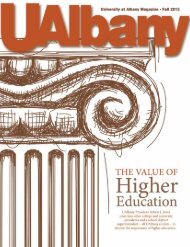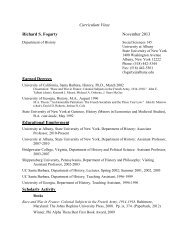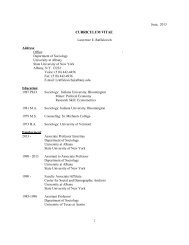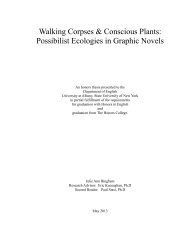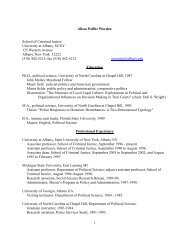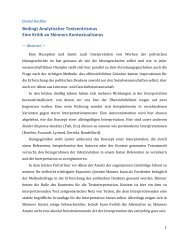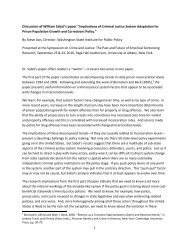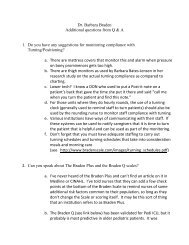Alvin Curran, "On Spontaneous Music" - University at Albany
Alvin Curran, "On Spontaneous Music" - University at Albany
Alvin Curran, "On Spontaneous Music" - University at Albany
Create successful ePaper yourself
Turn your PDF publications into a flip-book with our unique Google optimized e-Paper software.
Contemporary Music Review<br />
Vol. 25, Nos. 5/6, October/December 2006, pp. 483 – 490<br />
<strong>On</strong> <strong>Spontaneous</strong> Music<br />
<strong>Alvin</strong> <strong>Curran</strong><br />
The following reflections are written five years apart, the first in response to Sabine<br />
Feisst, for her doctoral thesis, the second written <strong>at</strong> the request of Giesela<br />
Gronemeyer for the present public<strong>at</strong>ion. The author begs the reader’s understanding<br />
for some occasional overlap.<br />
Improvis<strong>at</strong>ion is the art of becoming sound. It is the only art in which a human being<br />
can and must become the music he or she is making. It is the art of constant, <strong>at</strong>tentive and<br />
dangerous living in every moment. It is the art of stepping outside of time, disappearing in<br />
it, becoming it. It is both the fine art of listening and responding and the more refined art<br />
of silence. It is the only musical art where the entire ‘score’ is merely the self and the<br />
others, and the space and moment where and when this happens. Improvis<strong>at</strong>ion is the<br />
only musical art which is predic<strong>at</strong>ed entirely on human trust.<br />
The art of improvis<strong>at</strong>ion assumes (and for me unequivocally proves) th<strong>at</strong> human<br />
beings are musical beings and th<strong>at</strong> not unlike the gre<strong>at</strong> n<strong>at</strong>ural musicians of the<br />
animal kingdom—from crickets and cicadas to whales, wolves and lions—all human<br />
beings are born with, possess and particip<strong>at</strong>e in some form of music.<br />
Regardless of the musical context (the people, place or time, tradition or style), the<br />
art of improvis<strong>at</strong>ion puts the full responsibility for the music being made on the<br />
person/s making it, and for the entire dur<strong>at</strong>ion of its making.<br />
Hence, in free improvis<strong>at</strong>ion the prevailing notions about the origins of music<br />
(the gods, collective memory, composers, mythology, etc.) are temporarily eclipsed<br />
by the sheer magical energy of the physical person/s making the music—for it is<br />
they who are momentarily but fully responsible for the sounds they make. It is<br />
they, the improvisers, in whom the traditional roles of composer, performer,<br />
director and teacher are fused into one single role. It is they who, in every sense,<br />
become—literally are—the music they make; and <strong>at</strong> best, transform everyone and<br />
everything into th<strong>at</strong> music—th<strong>at</strong> sharing of air, time and space. This is<br />
immedi<strong>at</strong>ely as evident on hearing an improvised cadenza in a Beethoven piano<br />
concerto as it is in hearing Coltrane’s endless conc<strong>at</strong>en<strong>at</strong>ions on the song ‘My<br />
Favorite Things’ or in a Dagar Brothers levit<strong>at</strong>ing performance of an evening raga.<br />
And this is even far more evident in musics not rooted in tradition, but in<br />
continuing experiment and research; such spontaneous musics could be said to be<br />
based on almost ‘nothing’.<br />
ISSN 0749-4467 (print)/ISSN 1477-2256 (online) ª 2006 Taylor & Francis<br />
DOI: 10.1080/07494460600989994
484 A. <strong>Curran</strong><br />
Improvised music is, however, generally based on something: a word, a set of fixed<br />
tones, a melody, rhythmic p<strong>at</strong>tern, chordal sequence, timbral change, gesture (crescendo,<br />
diminuendo, fragment<strong>at</strong>ion, drone, etc.), a reaction, a memory, a dream. Or any<br />
combin<strong>at</strong>ion of these. All musical cultures employing forms of improvis<strong>at</strong>ion codify<br />
these forms around a specific set of sounds developed through a long historical process.<br />
The history of ‘western’ twentieth-century music in its modernist and<br />
postmodernist <strong>at</strong>tributes can be viewed as a series of <strong>at</strong>tempts to liber<strong>at</strong>e music<br />
from various forms of tyranny—rules and traditions real or imagined: triadic<br />
harmony, memorable melody, the twelve equal-tempered tones, metered regular<br />
pulse, European orchestral timbres, ranges of instruments, standardized dur<strong>at</strong>ions,<br />
fear of disorder and chaos, the fear of silence. In the middle and l<strong>at</strong>e 1960s we<br />
witnessed <strong>at</strong>tempts to embrace all of these aspects of musical liber<strong>at</strong>ion while<br />
focusing <strong>at</strong> the same time on the philosophical, political, and economic liber<strong>at</strong>ion of<br />
music from itself—th<strong>at</strong> is, the freeing of music even from the need to liber<strong>at</strong>e itself.<br />
Nevertheless, a momentary and generalized ‘freeing’ of music, not only of all former<br />
musical ideology and practice, but from its fiercely rooted social and economic basis<br />
in the West, became the utopian challenge taken up in many different ways, by a<br />
number of dedic<strong>at</strong>ed musicians throughout the world. La Monte Young in New York<br />
City, Larry Austin and Pauline Oliveros in California, Takehisa Kosugi (the Taj<br />
Mahal Travelers) in Japan, Terry Riley, Glass and Reich, Tudor and Cage, Christian<br />
Wolff, the Sonic Arts Union (Behrman, Ashley, Mumma, Lucier), Franco<br />
Evangelisti’s ‘Gruppo Nuova Consonanza’, Gavin Bryar’s Portsmith Symphonia,<br />
Cardew’s Scr<strong>at</strong>ch Orchestra, The <strong>Spontaneous</strong> Music Ensemble – London and in<br />
individual voices such as Alexander von Schlippenbach, Evan Parker, Peter Kowald,<br />
Misha Mengelberg, The AACM (Muhal Abrams, Anthony Braxton) in Chicago, as<br />
well as n<strong>at</strong>ural sound-artists Annea Lockwood and Maryanne Amacher etc.<br />
The improvis<strong>at</strong>ion groups AMM in London and Musica Elettronica Viva (MEV) in<br />
Rome, however, can be said to have taken the most radical position in regard to this<br />
process of ‘liber<strong>at</strong>ion’. Musically speaking, both groups were <strong>at</strong>tempting to literally<br />
reinvent music from zero. With revolutionary fervor, yet in a most pacific way,<br />
everything pertaining to the art of music (within their imagin<strong>at</strong>ions) was called into<br />
question. And while these groups had no boards of inquisitors—there were no trials,<br />
prison sentences, tortures or disappearances—they tacitly agreed on a new musical<br />
practice which would invest each member of the group with the responsibility for<br />
every sound made, thus heightening the individuals’ listening awareness and playing<br />
responses to all the sounds made <strong>at</strong> any instant (however simple or complex), as well<br />
as heightening their overall sense of commitment to the work; they further agreed<br />
th<strong>at</strong> any audible or imaginable sound, or sound source, was equally valid as raw<br />
musical m<strong>at</strong>erial. This, indeed, gave birth to some of the most remarkable musics of<br />
the time and, as far as one knew (in l966), there had never before been a music made<br />
on such far-reaching principles of individual freedom and democr<strong>at</strong>ic consciousness;<br />
this was collective music pure and simple—and without knowing it, a stunning artistic<br />
example of political anarchy. From my experience in the founding of the group<br />
Musica Elettronica Viva, I would like to describe wh<strong>at</strong> I believe were the principal
codes of action and expected behavior and implicit str<strong>at</strong>egies and goals of our group<br />
improvis<strong>at</strong>ions—the music in all of its various phases has been described and<br />
documented elsewhere.<br />
Wh<strong>at</strong> the group MEV (along with AMM) essentially did was to redefine music as a<br />
form of property th<strong>at</strong> belonged equally to everyone and hence to encourage its<br />
cre<strong>at</strong>ion freely by and through anyone anywhere. This idea alone had gre<strong>at</strong><br />
implic<strong>at</strong>ions for the art of improvis<strong>at</strong>ion, for it brought forth a new and quite flexible<br />
code of behavior based on the following principles:<br />
0) Any physical space is a potential musical space as is any time of day or night an<br />
appropri<strong>at</strong>e musical time.<br />
1) All music starts anew each time, as if there had never been any music before it.<br />
2) Any member of the group may utilize any audible or imaginable sound <strong>at</strong> any<br />
time.<br />
3) Musical remembering and musical amnesia are of equal value—in short, one<br />
could build on past or conditioned experience or try to forget everything ever<br />
known.<br />
4) The requirements for musical particip<strong>at</strong>ion are no longer based on purely<br />
musical skills, educ<strong>at</strong>ion, technique, experience, age, gender, race or religion<br />
but on an implicit code of universal harmony and mutual acceptance. This<br />
resulted immedi<strong>at</strong>ely in a form of transn<strong>at</strong>ional music.<br />
5) Each player provides his/her own instruments and sound sources.<br />
6) The act of collective performance has no specified dur<strong>at</strong>ion and performances<br />
begin and end by tacit (musically understandable) agreement.<br />
7) Without leaders, scores, or any rules <strong>at</strong> all, the music should be based on the<br />
musicians’ mutual respect for and trust in one another, the public, and the<br />
individual and sum of all the sounds emitted into the performing space.<br />
8) Because this music is fragile and dangerously based on almost nothing<br />
(ephemeral sounds and precarious human rel<strong>at</strong>ionships), the players must<br />
cultiv<strong>at</strong>e extraordinary levels of <strong>at</strong>tention, awareness and artistic efficiency—<br />
primarily through silence and rigorous listening, and appropri<strong>at</strong>e action and<br />
reaction—so to prevent the music from becoming literally nothing. This form<br />
of personal and collective commitment endowed everyone involved (including<br />
the producers and public) with finely tuned ears and magnanimous <strong>at</strong>titudes.<br />
9) No m<strong>at</strong>ter wh<strong>at</strong> transpires, a sense of transcendent unity is likely to be the<br />
unspoken goal of every improvis<strong>at</strong>ional event. (This sense of unity, though not<br />
always achieved, is very recognizable, almost tangible in certain moments.<br />
Especially when one cannot answer the questions: ‘did I make th<strong>at</strong>/did we<br />
make th<strong>at</strong>/did you make th<strong>at</strong>/did they make th<strong>at</strong>?’<br />
10) All members share equally in the promotion, economic stability and cre<strong>at</strong>ive<br />
growth of the group—in return for an equal share in received proceeds.<br />
11) This is a space for your own contribution.<br />
15 – 17 July 1995<br />
Contemporary Music Review 485
486 A. <strong>Curran</strong><br />
Postscript: From the Bottom of the Soundpool<br />
. . . somewhere between 28th St and Columbus Circle a total freak in dreads, dashiki,<br />
sandals and some toy antennae bobbing on his head gets into the number 1, uptown<br />
train. He’s clutching a destroyed alto saxophone—looked like it came out of the<br />
scrap metal yard. Without any warning he begins to blow into this mangled<br />
instrument, emitting screeching sheets of murderous high frequencies altern<strong>at</strong>ing<br />
with truck-horn-like jolting bl<strong>at</strong>s. After an initial assault of about 45 seconds, he<br />
cuts short and says, deadly serious: ‘Folks, if you want me to stop playing this<br />
music, just kindly drop a coin in the cup.’ The well-groomed morning travelers<br />
offered no resistance, and dutifully dropped coins in this ‘alien’s’ cup; as promised,<br />
he did not play again. I thought, Man! Wh<strong>at</strong> an original economic str<strong>at</strong>egy—getting<br />
the public to pay you not to make your music!!!!! My god, wh<strong>at</strong> if after 1945 the<br />
new music community—instead of madly searching for the new Beethoven among<br />
us—had adopted the brilliant str<strong>at</strong>egy of this New York City street artist: offering<br />
not to play its music, in exchange for money!!!!! We’d probably all be sipping cool<br />
drinks in an Internet cafe in Tahiti today r<strong>at</strong>her than sitting in airless halls listening<br />
to interminable gr<strong>at</strong>ing sonic aggreg<strong>at</strong>es, still waiting for some illumin<strong>at</strong>ion or new<br />
saint to appear.<br />
I have just finished listening to and remastering 16 hours of recorded tapes of the<br />
group Musica Elettronica Viva—which I co-founded. In its heyday (1966 – 1973), this<br />
indefinable group was considered benignly revolutionary by an <strong>at</strong>tentive European<br />
mainstream press and was a musical icon on the fringe of the fringe counterculture.<br />
Wh<strong>at</strong>ever the merits of the group’s music, MEV—its actions as well as its music—<br />
struck fear into the heart of the music establishment, because it believed th<strong>at</strong> the<br />
music was the property of no one individual or author, but th<strong>at</strong> of the group, and<br />
th<strong>at</strong> music is a universal human right, and any human being, by mere will, can also be<br />
a music-maker.<br />
Incidentally, these two beliefs are now again <strong>at</strong> the center of an ethical and legal<br />
deb<strong>at</strong>e over the definition of music and its ownership and use on the Internet.<br />
At the beginning of the 30-plus years of MEV history, the original core group<br />
(Alan Bryant, <strong>Alvin</strong> <strong>Curran</strong>, Jon Phetteplace, Carol Plantamura, Frederic Rzewski,<br />
Richard Teitelbaum, Ivan Vandor) took for granted the inherent value of a fixed<br />
group structure as such. But in time, as we became accustomed to playing with many<br />
self-invited guests—and even with many so-called non-musicians—a concept<br />
emerged, largely promoted by Rzewski, to cre<strong>at</strong>e a music by inviting the general<br />
public to particip<strong>at</strong>e, without any structure or rules: the ‘Sound Pool’ announced,<br />
‘Bring a sound, cast it into the pool’ and people did; they came in droves and often<br />
left <strong>at</strong> the forced invit<strong>at</strong>ion of the local police and fire departments. ‘Sound Pool’ was<br />
both an open request and an authoriz<strong>at</strong>ion for anyone to make ‘music’ together as<br />
they pleased—freely.<br />
These were not jam sessions nor happenings (both of which are based on<br />
determin<strong>at</strong>e themes and structures), but collective music events for many people
Contemporary Music Review 487<br />
(usually 50 or more) which, after an initial launching by MEV’s c<strong>at</strong>alytic example,<br />
inevitably developed into independent throbbing dense polyphonies, multiple walls<br />
of sound of any color, speed, density and feeling. The ‘Sound Pool’ was often enacted<br />
in large rooms, where groups of musicians could form casually, play independently<br />
and dissolve into other groups, where individuals could wander from place to place<br />
playing offhandedly with an anonymous passerby or stopping to join in a small or<br />
large ongoing pocket of music. In short, a sea of freely mut<strong>at</strong>ing human symphonies<br />
which could <strong>at</strong> certain moments bring to mind a Cage ‘Music Circus’, a Pauline<br />
Oliveros ‘Medit<strong>at</strong>ion’, or even a Globe-Unity mass improv., though none of those<br />
models suffice to describe the levels of ecstasy or life-thre<strong>at</strong>ening chaos gener<strong>at</strong>ed<br />
during some of them.<br />
These were musics characterized above all by a shocking absence of authority or<br />
leadership, which <strong>at</strong> times shocked even us. They were based on the principle th<strong>at</strong><br />
anyone making any sound in any way (alone or in company) could consider this act<br />
to be an act of spontaneous music-making. I am not speaking here of ‘improvis<strong>at</strong>ion’,<br />
which I consider to be a highly specialized artistic behavior, but am merely describing<br />
wh<strong>at</strong> might be the most fundamental, perhaps primordial, level of musical<br />
consciousness and st<strong>at</strong>e of collective-spontaneous sounding together.<br />
Thus anonymous individuals in the act of collective liber<strong>at</strong>ion became their own<br />
musics, and the ‘Sound Pool’ was the sum of all of them—as if in a mass spontaneous<br />
urban psychodrama. This work—a radical assault on the sacred cows of bourgeois<br />
culture—was <strong>at</strong> once an act of conceptual suicide for the music of the ‘closed’ group<br />
and <strong>at</strong> the same time an act which raised the collective music concept to its most<br />
dangerous and unstable experimental limits; it further precipit<strong>at</strong>ed an intense deb<strong>at</strong>e<br />
among core MEV members—a deb<strong>at</strong>e which centered on the n<strong>at</strong>ure of music,<br />
composition, improvis<strong>at</strong>ion and the social limits of these newly cre<strong>at</strong>ed music rituals.<br />
To balance the musical needs and sanity of the group, a plan emerged where we<br />
would divide an evening in two parts: the first would focus on open-form<br />
compositions—often works of our own; and the second part, usually initi<strong>at</strong>ed by<br />
Christian Wolff’s ‘Sticks’, would lead to the ‘Sound Pool’ proper.<br />
In the context of these liber<strong>at</strong>ional melees, improvis<strong>at</strong>ion per se was an academic<br />
issue. Yet improvis<strong>at</strong>ion and the individual skills we had all quickly developed was a<br />
kind of sacred burning bush which has remained a strong source of inspir<strong>at</strong>ion to<br />
most of us to this day, as well as to a large number of musicians who performed with<br />
us in the seventies and eighties (Garrett List, Steve Lacy, Anthony Braxton, Maryanne<br />
Amacher, Karl Berger, to name a few). Group improvis<strong>at</strong>ion, as I defined it earlier, is<br />
music-making which embraces all of the contradictions of indeterminacy and hence a<br />
commitment to indetermin<strong>at</strong>e aesthetics; it demands refined skills in both the<br />
extensions of classical instrumental technique as well as analog and digital electronic<br />
techniques combined with lightning fast decision making, repression of the ego, and<br />
mutual trust; but above all it is centered on the newly emerging skill for the<br />
individual players to perceive the totality of music not only in the present, but in the<br />
past and future as well.
488 A. <strong>Curran</strong><br />
While these performance consider<strong>at</strong>ions of trained composers and performers<br />
applied to MEV music <strong>at</strong> all times, the group aesthetic also embraced a liber<strong>at</strong>ional<br />
anarchism, in apparent dialectical contradiction—which brings us back to the sixties’<br />
Zeitgeist. Both in the closed group improvis<strong>at</strong>ions of early MEV (often called<br />
‘Spacecraft’) and the mass ‘Sound Pool’ events, one of the main collective goals was<br />
the gener<strong>at</strong>ion of a kind of tribal energy, with wh<strong>at</strong>ever means it took: from skillfully<br />
crafted improvis<strong>at</strong>ion to reckless indeterminacy, from loose associ<strong>at</strong>ions to free ones,<br />
from induced mental st<strong>at</strong>es akin to autism and amnesia to illumin<strong>at</strong>ing st<strong>at</strong>es of<br />
unity—awareness of everyone and everything. At once de<strong>at</strong>h-defying, life affirming<br />
and ecstasy seeking, grounded in a vol<strong>at</strong>ile mix of the politics of Anarchy,<br />
Communalism, and Transcendentalism, the music was unmedi<strong>at</strong>ed, idiosyncr<strong>at</strong>ic<br />
and raw. No Ivy-League-via-Darmstadt bleep-blop, no spotless minimalisms, no<br />
frills, no money back, just plain musical vulcanism, straight up. It was these essential<br />
qualities th<strong>at</strong> fascin<strong>at</strong>ed and terrified the establishment, as they in their mand<strong>at</strong>ed<br />
ways <strong>at</strong>tempted to tame us and own us and our music—our ‘work’ brought<br />
everything into question, including authors’ rights and the n<strong>at</strong>ure of a public concert.<br />
The crude amplified sounds we made often took the form of an extended primal<br />
scream . . . anyone in their right minds would have paid us not to play, but alas no one<br />
had the imagin<strong>at</strong>ion or courage to do th<strong>at</strong>. Instead, the mixture of adventurousness,<br />
uncertainty and utopian enthusiasm typical of the times spurred our project on.<br />
MEV’s founders were mostly composers, refugees from esteemed American<br />
academies, living precariously in Europe and dedic<strong>at</strong>ed to the idea of experimental<br />
music. Youthful, even naïve, we all shared a desire to strip ourselves naked, liber<strong>at</strong>ing<br />
ourselves from the vestments of the past and present. Our techniques and concepts<br />
grew directly from the fertile soil prepared by Cage, Tudor and Mumma in the l<strong>at</strong>e<br />
fifties—early sixties and by the work of the AACM (American Associ<strong>at</strong>ion of Cre<strong>at</strong>ive<br />
Music) and the Arts Ensemble of Chicago. But in contrast to the advanced theorizing<br />
and m<strong>at</strong>hem<strong>at</strong>ical rigor within the Cage circle, MEV felt its sense of mission as an<br />
existential drive to live in the moment, including our hand-to-mouth economy—in<br />
fact, we often could not see far beyond th<strong>at</strong> to fully comprehend the global meaning<br />
of all th<strong>at</strong> was going on. This drive was a manifest reality of the ’68 counterculture,<br />
and this above all was our guide, the voices of our teachers (Carter, Babbitt, Sessions,<br />
Petrassi, Nono, Mel Powell) notwithstanding.<br />
Wh<strong>at</strong> was revolutionary in our vanguard music was the process, even more than<br />
the product. The music began as it ended, based on telep<strong>at</strong>hic signals. It did not<br />
m<strong>at</strong>ter wh<strong>at</strong> found objects we rubbed, scr<strong>at</strong>ched or banged on, wh<strong>at</strong> we blew into or<br />
how, wh<strong>at</strong> we dropped on the floor or be<strong>at</strong> on the walls, wh<strong>at</strong> instruments we played<br />
conventionally or unconventionally, wh<strong>at</strong> home-made or sophistic<strong>at</strong>ed electronic<br />
circuitry was employed and so on—wh<strong>at</strong> m<strong>at</strong>tered is th<strong>at</strong> we did it, ‘punto e basta’,<br />
th<strong>at</strong> the urgency of the moment to focus our collective <strong>at</strong>tentions onto a challenging<br />
act of spontaneous cre<strong>at</strong>ion was wh<strong>at</strong> m<strong>at</strong>tered. Whether the music was tonal or<br />
<strong>at</strong>onal or microtonal, repetitive or disjunct or fragmented, sequential or continuous<br />
or sweet/sexy or abrasive, violent or disgusting, banal or even idiotic m<strong>at</strong>tered little,
Contemporary Music Review 489<br />
in comparison to the singular task of keeping the musical energy high and unified,<br />
efficient and in constant evolution.<br />
To do this, to make music obliter<strong>at</strong>ing any awareness of rel<strong>at</strong>ed tradition or<br />
predetermined structures, required an enormous self-discipline, commitment and<br />
momentary suspension of the individual’s self. It required above all a new expanded<br />
musicality, one th<strong>at</strong> could equ<strong>at</strong>e beauty with ugliness and vice versa. The resulting<br />
musics were liber<strong>at</strong>ing in every sense . . . After performances, r<strong>at</strong>her than return to<br />
reality as if we had been casually experimenting in a scientific lab, we returned often<br />
with the shared knowledge th<strong>at</strong> we had all been somewhere, on a voyage—in the<br />
same illusive and unnamable space—unified by making the same music together, as if<br />
it had been composed, magically composed . . . and this music we knew was ours, we<br />
had in fact composed and performed it in the moment—bang-zoom!! Just like th<strong>at</strong>.<br />
Wh<strong>at</strong>ever else remains of the MEV legacy, we challenged the noble traditions of<br />
western music in a new and untried way: by daring to reverse the ‘proper’ professional<br />
balance between technique and passion, by asserting—I’ll say it again—th<strong>at</strong> we, and in<br />
fact anyone, could make a music based on nothing, with any sounding means and<br />
without written score, sketch, agreement, leadership or even, we hoped, memory. Th<strong>at</strong><br />
in fact we could make music of powerful emotive content and <strong>at</strong>traction outside the<br />
canons of historical western compositional practice was a profound discovery to all of<br />
us in the group and to many outside. The collective process and a few early (middlesixties)<br />
electronic technologies allowed us to extract the hidden sounds inside any<br />
object, or from the entire sounding environment, or from electricity itself, as well as<br />
those drawn from the depths of the human mind and body—this was the nuclear<br />
m<strong>at</strong>ter of our daily experimental live-electronic group improvis<strong>at</strong>ions.<br />
Th<strong>at</strong> the utopian cultural implic<strong>at</strong>ions of this practice were in succeeding decades<br />
absorbed, codified, expanded on, contested, marginalized, even somewh<strong>at</strong> forgotten<br />
is history’s n<strong>at</strong>ural way. Thirty-five years l<strong>at</strong>er, as I sit here in the July he<strong>at</strong>, it seems<br />
to me th<strong>at</strong> the revolution we had the privilege of particip<strong>at</strong>ing in has evolved into<br />
largely standardized improvis<strong>at</strong>ory practices (some still vital, others not) th<strong>at</strong> all in<br />
some way had their origins in those mad fortuitous encounters among Free Jazz,<br />
Indeterminacy, European structuralist composition, explosive countercultures, and<br />
movements for social and economic justice. <strong>On</strong>e could even argue th<strong>at</strong> today’s<br />
sizeable worldwide free-improvising community, while apparently alive and well, is<br />
making music in a temporal cul de sac a predictably common practice. Is this music<br />
movement <strong>at</strong> an end, buried in no longer provoc<strong>at</strong>ive <strong>at</strong>onalisms, collage, and macho<br />
virtuosity, and overshadowed by the economic power of mainstream jazz, the<br />
gravit<strong>at</strong>ional forces of the European New Music ‘Betrieb’, and more youthful forms<br />
of hip-hop, noise and electronics—all which have successfully incorpor<strong>at</strong>ed elements<br />
of the earlier freely improvised music styles? I ask myself, will the myth of Schoenberg<br />
outlive the myth of Cecil Taylor, or will both of them fade while Beethoven and Dr.<br />
Dre slip away with the culture bounty?<br />
In retrospect, maybe not much of the sixties experience was truly revolutionary,<br />
and less of it had profoundly transform<strong>at</strong>ive consequences, but 30 years l<strong>at</strong>er, as
490 A. <strong>Curran</strong><br />
trends and technologies in music are unfolding <strong>at</strong> a dizzying r<strong>at</strong>e, thankfully the<br />
confront<strong>at</strong>ion between progressive and regressive has not been globalized out of<br />
existence. The youth culture, without setting a foot in the piazza, imagines it can<br />
subvert the entire social and economic order by the simple click of a mouse. And with<br />
the planet now choking on its own voracious music consumption—music of every<br />
kind everywhere all the time—surely someone will be able, once again, to inject it<br />
with a wicked dose of orderly disorder. MEV is dead! MEV lives!<br />
Gallipoli, 6 August 2000, edited by Susan Levenstein<br />
http://www.alvincurran.com



